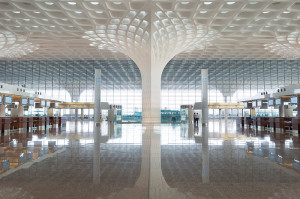Chhatrapati Shivaji International Airport – Terminal 2
Skidmore, Owings & Merrill LLP was an Outstanding Award Winner for the Chhatrapati Shivaji International Airport – Terminal 2 project in the 2014 NCSEA Annual Excellence in Structural Engineering awards program (Category – International Structures over $100M).
As recently as 15 years ago, only 6 million travelers used Chhatrapati Shivaji International Airport each year. Today the facility can accommodate more than 40 million passengers annually, and the new SOM-designed Terminal 2 building was created precisely to handle this greatly expanded scale of operation. The 4.4 million-square-foot building combines international and domestic passenger services under one roof, optimizing terminal operations and reducing passenger walking distances. In the building’s X-shaped plan, moreover, concourses radiate from a central processing core so they can “swing” between domestic and international service 24 hours a day.
The Terminal 2 scheme is as elegant as it is efficient – a point exemplified by its headhouse roof. Beautifully molded and punctuated by skylights, the roof spans four base structures whose programming includes roadside drop-off, check-in, and security and immigration. This 753,475-square-foot surface is supported by only 30 composite mega-columns. It is one of the world’s largest roofs without an expansion joint.
To achieve it, the mega-columns are spaced 210 feet in one direction and 112 feet in the perpendicular direction, and support a system of orthogonal 13-foot-deep steel trusses akin to a two-way flat slab. Truss depths increase near the mega-columns to create “column pod” areas, and the truss system cantilevers as much as 131 feet from the nearest mega-column at the roof edge.
Moreover, SOM separated the mega-
column-and-roof system from the four base structures, which comprise stacks of poured-concrete bays. Pierced openings in these stacks allow the mega-columns to ascend unimpeded, so that the headhouse roof responds independently to loads that most notably include expansion and contraction caused by temperature variation; thermal gradient was applied to the steel in the structural analysis model, and it informed the design and fabrication of individual roof members.
In addition to impacting response to loads, SOM’s disaggregation of the base concrete bays from the headhouse roof structure helps to produce the unique aesthetic of Terminal 2. The facility’s monumental spaces and mushrooming columns evoke the airy pavilions and interior courtyards of traditional Indian architecture.
Similar to the monumentally sized headhouse roof, Terminal 2 claims the title of having the longest and largest cable wall in the world. The facility’s two separate cable wall systems total over 3,280 feet in length and 118,403 square feet in area.
The cable walls employ unidirectional cables that span two vertical levels of the terminal structure. At the uppermost departures floor, for example, unidirectional cables were necessitated by the cable roof’s complete envelopment of the terminal headhouse, which precluded horizontal anchorage points. Here, expansion joints installed at the intersection of the cable wall and four base structures allows individual segments of the wall to move independently.
On the east and west sides of Terminal 2, meanwhile, the cable wall reaches to the cantilevered edge of the headhouse roof. Because the roof experiences large vertical deflections, a backup system prevents a loss of cable pre-tension due to roof deflections. In this system, composite columns cantilevering from concrete base structures are interconnected with structural steel girders at the top and bottom of the cable wall; the unidirectional cables span between these girders, and the top of the back-up system is supported laterally by the headhouse roof with dampers at composite column locations.
In addition to its unique size and length, the CSIA cable walls include a number of features rarely pursued elsewhere. To prevent collision between the curved portion of the wall and absolute corners, for example, corner cables are reinforced with horizontal stiffener plates connected between the cable and the corner column of the backup system. Variations in height and anchoring conditions, as well as the inclusion of corners, curves, and entrance vestibules, all mandated a very precise design of cable pre-tension. And owing to the shape and scale of the headhouse roof and cable wall, a wind-tunnel study was carried out to determine cladding pressures and structural roof loads.
These unusual efforts also supported the regionalist aesthetic. Because they are installed with insulated glass units, the cable walls create a diaphanous perimeter that makes Terminal 2’s pavilion-like appearance highly legible from afar.
The overall engineering solution yielded a variety of other positive outcomes. Among others, it is a tailor-made response to site constraints. The X-shaped plan molds Terminal 2 around the existing terminal, which had to remain operational during construction, and it incorporates modular designs to accommodate rapid phased construction. Moreover, the glazed cable wall works in tandem with the skylit headhouse roof and the piercings in the concrete base structures to maximize daylight penetration and reduce energy consumption. Finally, the mega-columns served as primary hoist mechanisms so that the headhouse roof could be constructed without the use of tower cranes; individual column pods were constructed atop one peripheral mega-column and then transported to their final location via temporary erection trusses.
Yet, of all these benefits, visual identity takes priority. CSIA bridges historic central Mumbai and its burgeoning peripheral neighborhoods, and Terminal 2 weaves the airport into the wider community in both form and function. Empowered by engineering, the building’s architectural expression has captured the heritage and vision of contemporary Mumbai.▪

